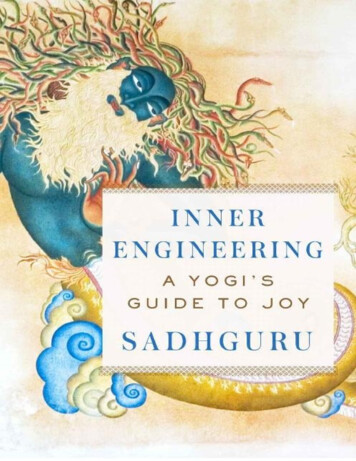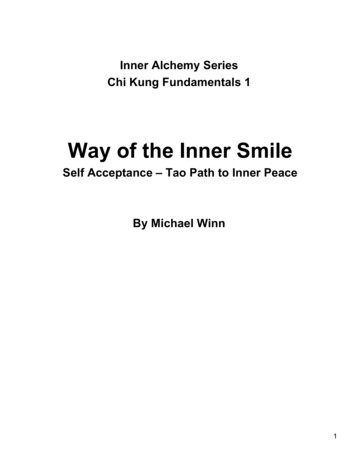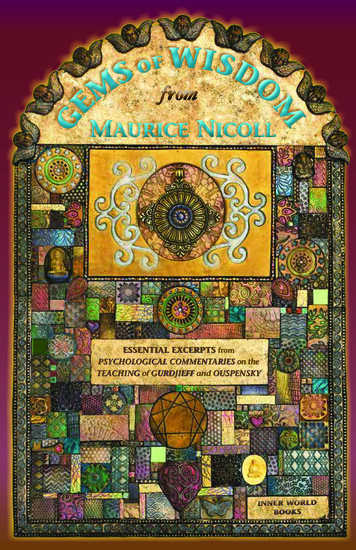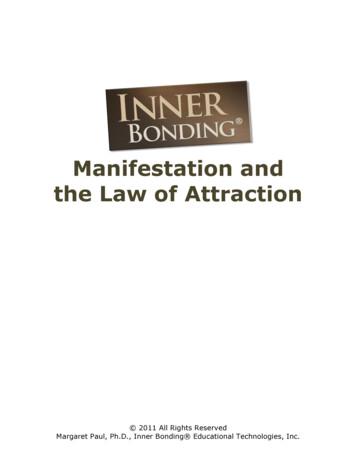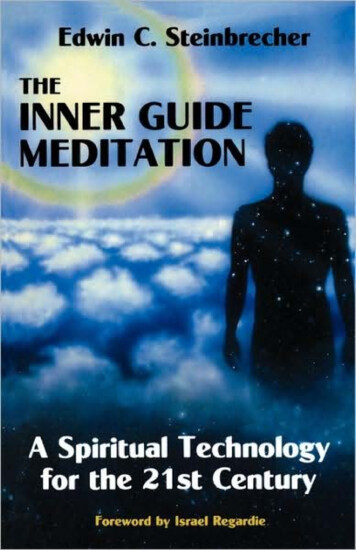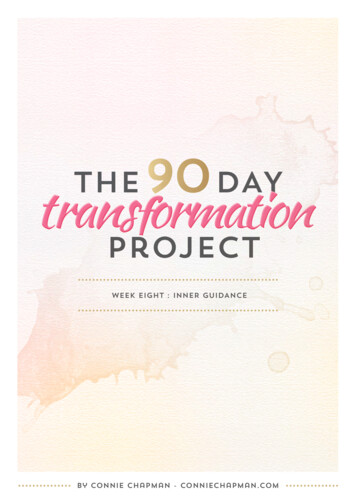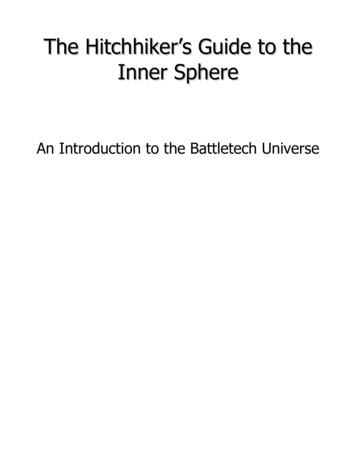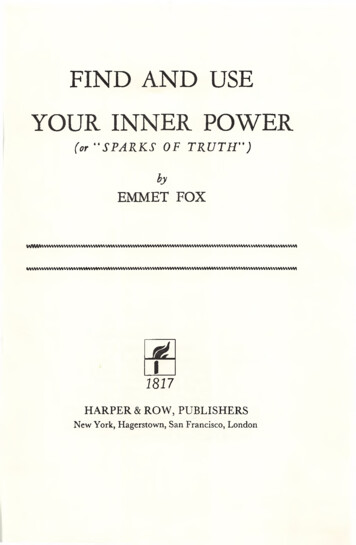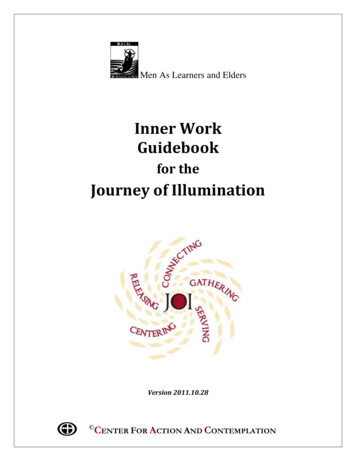
Transcription
Men As Learners and EldersInner WorkGuidebookfor theJourney of IlluminationVersion 2011.10.28 CENTER FOR ACTION AND CONTEMPLATION
Inner Work GuidebookMen As Learners and EldersQuestions about the content of this guidebook can be directed to: Joe Hebert (Louisiana) - joebear@attglobal.netBill McElroy (Illinois) - wmmcelroy@mcelroydds.comJim Clarke (California) - jclarke@stjohnsem.eduContentsSILENT RETREAT . 3VISION QUEST . 4LECTIO DIVINA . 5FAITH-SHARING GROUPS . 7DEATH LODGE . 8GUIDED RETREAT . 11YOGA . 12GUIDED MEDITATION/DEEP IMAGERY . 13LABYRINTH . 14FASTING . 15CONTEMPLATIVE PRAYER/CENTERING PRAYER . 16 CENTER FOR ACTION AND CONTEMPLATION2
Inner Work GuidebookMen As Learners and EldersSILENT RETREATDescription and Detail of ActivityWhat is a silent retreat?Typically, it is a time (usually more than one day) away from normalsurroundings in which a person spends the time in quiet. If others are present, theindividual refrains from conversation. A silent retreat works best when standard routineis set aside.Why do it?There may be a variety of reasons for going on silent retreats – rest, sleep, time innature, spiritual insight, guidance, journaling, etc; but the underlying idea is to take timeaway from the hectic, noisy, and distracting activities of life to recollect oneself and seekquiet and peace.How to do it?There are many ways to take a silent retreat, but one of the best is to scheduletime at one of the many retreat centers that specialize in this area. A person can attend anindividual or a group silent retreat, depending on how much structure is desired/required.If you choose to set up your own retreat, it is good to make the meals simple, so that youare not spending a lot of time with food preparation or clean up. The solo retreatant canalso schedule time at a retreat house. Often this type of retreat allows one to participatein spiritual direction once or twice a day, during which silence will be broken.You may also use “wandering in nature” as silent time, and can incorporate this ina “Death Lodge” ritual, in which silence is maintained throughout the day and into theevening hours when the ritual action would take place.Materials neededMainly what is needed is your presence, and the intention to let go of distractionsand to focus on the matters at hand. Materials might include your journal, bible, spiritualreading or poetry, a meaningful ritual object, symbol or icon which might be needed forself designed rituals. The locale and facility will dictate others items. For example, ifoutside, or camping, all appropriate equipment would be needed. In a retreat housemany, if not all, of your needs will be met except for the personal items mentioned.Suggested Resources for this retreat CENTER FOR ACTION AND CONTEMPLATION3
Inner Work GuidebookMen As Learners and EldersVISION QUESTDescription and Detail of ActivityWhat is “Vision Quest?’’“Vision Quest,” sometimes called a “Vision Fast,” is a rite of passage experiencewhich originated in some Native American cultures and developed over thousands ofyears in diverse cultures. Through this evolutionary process, a common frameworkemerged for the rites. The “Vision Quest,” in modern culture, is frequently led byfacilitators trained in the process who can provide a safe container for the experience tounfold. The core portion of the quest is undertaken outdoors, frequently in a harsh, desertenvironment. Vision Quests vary in length, but generally require 9 or 10 days in theoutdoors. This rite of passage symbolizes the passing from one life stage to the next.Why do it?The vision-quester is “called” to this experience from the depth of his or her soul,usually during a time of a life transition. A Vision Quest can be a powerful and deeplyspiritual life-changing experience.The Vision Quest experience is separated into three distinct stages. The first stageis “Separation.” This is a period of time in which the quester will prepare to sever fromthe former world and leave behind the life he/she has known.The second stage is “the Threshold.” This is sometimes referred to as a journey tothe “Sacred Mountain.” During this stage, the quester will be challenged to die to this oldlife and embrace the new. The Threshold stage experience is “solo” in nature. Thisusually includes fasting lasting for 3 to 4 days.The third stage is “Incorporation.” During this stage which generally extendsover the next year or so, the quester returns to society, and assumes the task of bringingthis new vision into the world for the benefit of the larger community.How to do it?Below is a short list of organizations which offer vision quest experiences. Theseare counted as having long, reliable histories. For a more complex search, you canresearch “vision quest” on the internet. It is important to trust the guide leading you andto have confidence that he is skilled in providing a safe experience; and in facilitating andmirroring your vision quest story in a deep and mythic way. It is very important toresearch these organizations carefully to find the best fit for your.Soulcraft by Bill PlotkinRites of Passage Vision Quest – http://www.RitesofPassageVisionQuest.orgAnimas Valley Institute – http://www.animas.orgThe School of Lost Borders – http://www.schooloflostborders.orgThe Seventh Quest – http://www.theseventhquest.com CENTER FOR ACTION AND CONTEMPLATION4
Inner Work GuidebookMen As Learners and EldersLECTIO DIVINADescription and Detail of ActivityWhat is it? A form of “spiritual reading” that represents a method of prayer to promotecommunion with God A time set apart to be quiet and reflect on the word of God and how it affects yourlife A form of prayer dating back to A.D. 220 practiced by Catholic monks, andwidely used today among Christians. The roots of Lectio Divina probably reachback into “Old Testament” days. After 1960, it experienced a resurgence acrossChristian denominations. This growth continues in our own present time. LectioDivina is comprised of four prayerful movements: lectio, meditatio, oratio, andcontemplatio.Why to do it? Deepen your spiritual life Learn to listen to the voice of God Affectively connect with the scripturesHow do it?Alone or in small groups.1ST Movement – Lectio Select some scripture to read. Get settled, assume acomfortable position and set your intention to be with God during this time ofprayer. Begin to read the scripture slowly and hear it as if you were hearing it forthe first time; imagine that it is God speaking to you. Do not think about thewords just simply allow the words to be heard. Read until you reach a word orverse that strikes you in any way challenge, new understanding, insight, etc. Ifyou are in a place where it is possible, read aloud.2nd Movement – Meditatio Continue to repeat the words/verse over and over toyourself or aloud, if possible. Do not evaluate or analyze the verse simplyrepeat it and pay close attention to what “movements” are occurringwithin feelings or emotions that are evoked. Remember it is as if God werespeaking to you. Be with the words until you feel that responding would beappropriate.3rd Movement – Oratio In this movement, give response to God from yourheart simply speak your response as you would speak with a close friend orloved one. You may even converse. “hearing” God speaking further with you,and you giving further response. CENTER FOR ACTION AND CONTEMPLATION5
Inner Work GuidebookMen As Learners and Elders4th Movement – Contemplatio Having finished with your response to God, younow move to “resting in God.” In this movement, God is still “communicating”or “working on you” it is just beneath the level of your awareness. You renewyour intention to simply be present with God at this level, beyond words.Suggested Resources for this utreach.org Click on Lectio Divina tab on the leftCovey, Michael; Sacred ReadingsHall R.C., Thelma; Too Deep For Words CENTER FOR ACTION AND CONTEMPLATION6
Inner Work GuidebookMen As Learners and EldersFAITH-SHARING GROUPSDescription and Detail of ActivityWhat is it? A group of Christian or like-minded men who meet regularly to review their faithlives over the previous week/month etc. A group of brothers who hold each other accountable.Why do it? To strengthen my commitment to my inner/spiritual life To strengthen the bonds with my brothers in the group Bond with men who will help and support each other Time to share joys and strugglesHow to do it? Sharing of scriptures including some form of ritual adhering to the Rules forSmall Groups as presented at your MROP. Reading books on faith, spiritual life, community building, or other books whichwill deepen the inner life. Commenting on the books and the ways in which thechapter touches your life. For MALE Planning groups use the 30-30-30 format. The first 30 minutes are forchecking in and keeping the edges hot. The second 30 minutes are for growth orsoul work as mentioned above. The third 30 minutes are for planning MALEactivities or future activities for the group.Suggested Resources for this Activitywww.malespirituality.orgClick on Suggested Format for Small Men’s Group Meetingswww.parishlife.com/faithshare1.htm (this is Renew Catholic site)www.gbod.org/evangelism/fsparticipants.pdf (Methodist - can’t find CfsIndex.doMensFSGUsresGuide Rev 4-28-08.doc (358 K)View as HTML Open as a Google document DownloadSuggestedMensFSGMeetingFormat Rev 4-28-08.doc (30 K)View as HTML Open as a Google document DownloadFirst Faith Sharing Group Agenda.doc (28K)View as HTML Open as a Google document DownloadFaith Sharing Commitment.doc (27K)View as HTML Open as a Google document Download CENTER FOR ACTION AND CONTEMPLATION7
Inner Work GuidebookMen As Learners and EldersDEATH LODGEDescription and Detail of ActivityWhat is it?The concept of the Death Lodge can be traced back to approximately 1500 BCEwhen rubber was first discovered by the Olmecs the mother civilization ofMesoamerica. The Death Lodge is part of an ancient teaching about the experience ofdying. This teaching was found throughout the Americas as far north as the Midwesternplains.According to the Cheyenne version, consciously preparing for death involves fourpsycho-spiritual stages. The first step consists of stepping onto the decision road, whichindicates that you have recognized that death is approaching and you have accepted thisfact. The next stage is the Death Lodge.The Death Lodge is the place where a dying person receives final visitors. If oldwounds still exist between the dying person and the visitor, this is the opportunity forforgiveness to take place between them. It is also a chance for final goodbyes.The last two stages, the Purpose Circle and the Great Ballcourt follow the DeathLodge, and are an accounting of one’s life and “playing ball with the Lords of Death” inthe transition between this world and the next. The “soul” is thought to pass back andforth during this time, immediately before the final physical death.Why do it?For our purposes, we will discuss the Death Lodge in and of itself. We haveheard the admonition that in order for one to live fully one has to first learn to die.There can be many occasions to die little deaths well before dying our final death. Manytimes we can live more fully by attending to these little deaths. Ask yourself: “Why waituntil the absolute end to face some of these issues, when I can confront them, name themand let go of them now (i.e. die to them), thus freeing myself to live more freely?”How to do it?PreparationPrior to the entering into the experience of the Death Lodge, use reflection,discernment and contemplation to determine what aspect of you has to die. Perhaps youmight consider over-identification with an attitude or person, an unhealthy relationship,some aspects of your false self you have identified, self absorption. Also consider yourLoyal Soldier and “his” strategies and behaviors. It is personal and specific to you andthe current situation attending your life field. Be specific and narrow this down to one ortwo issues.In selecting the focus of your Death Lodge experience, and using other inner workpractices/disciplines, begin to collect some symbols that will work for you, in focusing onthe aspects of your life which need to die. As the Death Lodge is an intentional period oftime in nature (generally 24 hours), assemble equipment necessary for being outdoors CENTER FOR ACTION AND CONTEMPLATION8
Inner Work GuidebookMen As Learners and Eldersovernight: correct clothing based on t
Inner Work Guidebook Men As Learners and Elders C ENTER FOR A CTION AND C ONTEMPLATION 6 4 th Movement – Contemplatio Having finished with your response to God, you now move to “resting in God.” In this movement, God is still “communicating”


